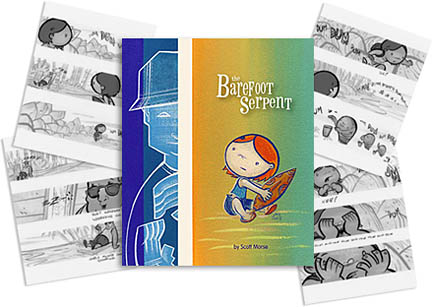
Once upon a time...
A myth-rich tale of loss and healing
in Hawaii marks a creative coup for
a comic book artist
With all the hype surrounding the current parade of mega-movie adaptations of superhero comic book characters, it can be tough to remember the simple joy of just reading a well-crafted book that comes without the Biff! and Bam! and Pow!
This is the case with "The Barefoot Serpent," by Scott Morse (Top Shelf Productions). Morse is known for his unique and deceptively simple drawing style, inspired by his previous studies in character animation at the California Institute of the Arts. While he's done some studio work for Disney, Universal and Cartoon Network, and is currently working on directing his own live-action film adaptation based on his 1920s gangster comic book "Volcanic Revolver," Morse has mainly distinguished himself as one of the most expressive comic book artists in the biz.
He's done the occasional project for the big boys Marvel and DC Comics, but it's his stuff for the independent publishers that has given Morse the creative leeway to do his best work.
What I think will interest Hawaii readers about "The Barefoot Serpent" is that part of its story takes place in what looks like to be an unidentified Kona on the Big Island. Bookended by a brief, full-color appreciation of the life and artistry of legendary Japanese filmmaker Akira Kurosawa, Morse writes and draws in gray tones a wonderful story about loss and healing as it relates to a vacationing haole family.
In his forward to the book, local-born "Usagi Yojimbo" creator Stan Sakai writes that he sees a lot of Kurosawa's cinematic influence on Morse's work in their common "economy of dialogue, letting the visuals carry the story." Sakai also writes that "I was raised in Hawaii ... (and although) I grew up (with) high-rises, traffic jams and blazing humidity, I much prefer Scott's version."
Morse's Hawaii is very much the myth-rich yet still grounded place we call home. The curious appearance of night marchers during the day sends a little haole girl headlong into the local culture, as represented by a boy who makes tiki masks for tourists.
I give credit to Morse for depicting the essence of Hawaii so well in his book, the little details, right down to his keen ear in capturing the lilt of our pidgin English. As the boy and girl spend the day together, the girl realizes by story's end that she, her dad and mom still share a strong bond of familial love despite the unexplained suicide of her brother.
It's that sense of perseverance that ties in with the parallel Kurosawa story. The filmmaker stayed true to his optimistic humanitarian vision throughout his rich life, despite the suicide of his own older brother Heigo.
Morse has mentioned in previous interviews that he meant for the overall design of "The Barefoot Serpent" to hark back to the way children's books looked in the 1940s and '50s, and it's that added touch, when combined with his expressionistic illustrations, that makes this such a special book, guaranteed to appeal to all ages, whether they live here or across the Pacific.
Click for online
calendars and events.

